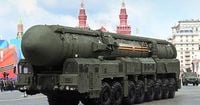Delegates from over 80 nations and a host of civil society organizations gathered in New York City on September 26, 2025, for the United Nations General Assembly’s annual commemoration of the International Day for the Total Elimination of Nuclear Weapons. The event, held against a backdrop of escalating global tensions and eroding arms control agreements, was marked by solemn warnings, impassioned appeals, and a renewed sense of urgency to address the perils of nuclear armament in a world where the threat seems less remote than ever.
UN Secretary-General António Guterres, whose message was delivered by Chef de Cabinet Courtenay Rattray, did not mince words. “We gather under a shadow that should have been lifted long ago,” Guterres warned, describing nuclear weapons as a “threat born of human design—and prolonged by human folly.” He cautioned that the world is “sleepwalking into a new nuclear arms race; more complex, more unpredictable and even more dangerous.” According to People’s World, Guterres called on nuclear-armed nations to “return to dialogue,” take concrete steps to prevent catastrophic miscalculations, and ensure all nuclear weapons remain fully under human control.
The timing of this year’s commemoration was poignant, coinciding with the 80th anniversary of two events that have left indelible marks on humanity: the U.S. atomic bombings of Hiroshima and Nagasaki in 1945 and the founding of the United Nations itself. Both events serve as stark reminders of the devastation nuclear weapons can unleash and the enduring hope that international cooperation can offer a path to peace.
Notably, the International Day for the Total Elimination of Nuclear Weapons was established in 2013, with September 26 chosen to honor the actions of Soviet officer Col. Stanislav Petrov, who, in 1983, averted a potential nuclear disaster by correctly identifying a missile launch warning as a false alarm. Guterres urged the 191 countries that have signed the Treaty on the Non-Proliferation of Nuclear Weapons (NPT), including the five original nuclear powers—the U.S., UK, China, Russia, and France—to fulfill their treaty obligations. He also encouraged all nations to follow the example of the 95 countries that have signed the Treaty on the Prohibition of Nuclear Weapons (TPNW), 74 of which have ratified it.
“On this International Day for the Total Elimination of Nuclear Weapons,” Guterres declared, “let us make long needed progress to forge a world free of these weapons of extinction. Let us build that world together—with courage, conviction and concrete action.”
As the meeting opened, Annalena Baerbock, President of the General Assembly, set the tone: “While we cannot be naïve about the world as it is, neither can we give up on the world as it should be. It’s in our hands. Our efforts must persevere … because we know it’s the right thing to do. Global security rests not in ever-growing arsenals, but in disarmament, in nonproliferation and—one day—in abolition.”
Yet, the day’s events unfolded amid mounting anxiety over the unraveling of arms control agreements. Delegates from China, India, and Pakistan were the only representatives of the nine nuclear-armed states to speak; the U.S. seat remained conspicuously empty. Many speakers stressed the urgency of broadening support for the TPNW and achieving progress at the upcoming NPT review conference scheduled for April and May 2026 in New York.
Japan’s Ambassador Nakamura Kimitake, representing the only country to have suffered nuclear attacks in war, emphasized his nation’s unwavering commitment to nuclear disarmament since 1946. He spoke movingly about the importance of remembering the hibakusha—the survivors of Hiroshima and Nagasaki—and ensuring their stories are passed down. “We must never give up until our resolute leadership and concerted efforts bring about our shared goal of a world without nuclear weapons,” Nakamura said.
Other nations, scarred by the legacy of nuclear testing, made their voices heard. Akan Rakhmetullin, Kazakhstan’s first deputy foreign minister, recounted his country’s “tragic legacy” of over 450 nuclear tests at Semipalatinsk. After gaining independence in 1991, Kazakhstan closed its test site and voluntarily relinquished what was then the world’s fourth largest nuclear arsenal. “That decision was an act of principle, transforming tragedy into responsibility. It defines our national identity and our role as committed to peace,” Rakhmetullin told delegates.
Hilda Heine, president of the Marshall Islands, recounted the devastating impact of 67 U.S. nuclear tests conducted between 1946 and 1958, including the infamous Castle Bravo test. “The Bravo shot caused the darkest day in the history of my people, and its consequences have carried through over the generations. We became sick with cancers, infertility, stillbirths and the births of ‘jellyfish babies,’” Heine said. Even today, radioactive contamination prevents some Marshallese from returning to their ancestral lands.
Uganda’s Foreign Minister Jeje Odongo Abubhakar, speaking for the Non-Aligned Movement’s 121 member states, reiterated that nuclear disarmament remains their highest priority and called for urgent negotiations to eliminate these weapons. Iran’s Mohammad Hassani-Nejad condemned the introduction of more “usable” nuclear weapons by the U.S. and others, reaffirmed Iran’s commitment to total elimination, and called for a nuclear-free Middle East.
Civil society representatives, including hibakusha Tanaka Satoshi and Vatican official Archbishop Paul Richard Gallagher, echoed the urgency. Satoshi warned, “As a hibakusha who has lived to the age of 81, I feel compelled to raise a warning: the fear that all of humanity may become hibakusha. This is the lived experience of one who has felt the reality of the nuclear age first-hand… We must act now, before it is too late.” Gallagher, meanwhile, highlighted the dangers of integrating artificial intelligence into military systems, urging nations to join the TPNW as a concrete step toward a nuclear-free world.
In a Joint Appeal, more than 500 organizations called on all countries to declare the threat or use of nuclear weapons inadmissible, to stand down nuclear forces, and to commit to elimination by the UN’s 100th anniversary in 2045. They also advocated redirecting the billions spent on nuclear arsenals toward urgent global needs—peace, protection, and sustainable development.
Meanwhile, the international arms control landscape is shifting. Just days before the UN meeting, Russian President Vladimir Putin offered to maintain New START treaty limits on U.S. and Russian strategic nuclear forces for one additional year beyond February 2026. According to RUSI, Putin described New START as having “played a constructive role in maintaining balance and predictability in the sphere of strategic offensive weapons” and warned that abandoning it would be “a grave and short-sighted mistake.”
However, skepticism abounds. While Russia has politically committed to New START’s numerical limits—1,550 deployed warheads, 700 deployed missiles and bombers, and 800 deployed and non-deployed launchers—it has suspended all verification measures, including on-site inspections and data exchanges. The U.S., with its open budgeting and oversight, finds itself at a disadvantage, as Russia provides scant public information about its nuclear forces.
Putin’s timing reflects Russia’s own constraints. As RUSI reports, Russia’s nuclear modernization faces developmental setbacks, notably with the RS-28 Sarmat missile, and economic woes exacerbated by the war in Ukraine. Export controls and sanctions have hampered Russia’s access to critical technologies for advanced weapons systems. Recent Ukrainian attacks have further damaged Russia’s strategic bomber fleet, complicating its deterrence posture.
U.S. officials are wary. Accepting Putin’s offer might constrain U.S. options, especially as Washington grapples with how to deter both Russia and a rapidly modernizing Chinese nuclear arsenal. The lack of verification and Russia’s history of exploiting arms control loopholes have led many in Washington to urge caution and demand a broader, more enforceable agreement that addresses all warheads and new delivery systems.
As the world marks eight decades since the Hiroshima and Nagasaki bombings and the birth of the United Nations, the stakes could hardly be higher. The calls for action at the UN—and the debates over arms control proposals—underscore a shared recognition: the shadow of nuclear weapons still looms, and the path to their elimination is fraught but essential. The coming months may well determine whether the world steps back from the brink or slides further into a new, more perilous nuclear era.




